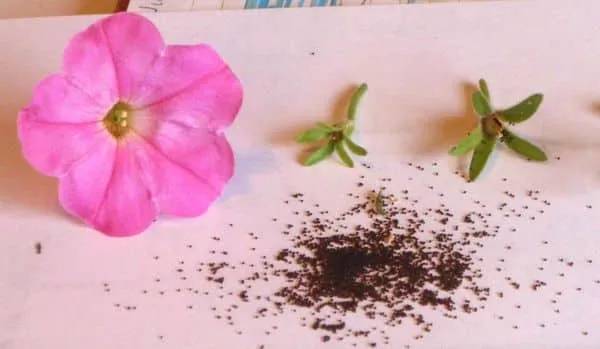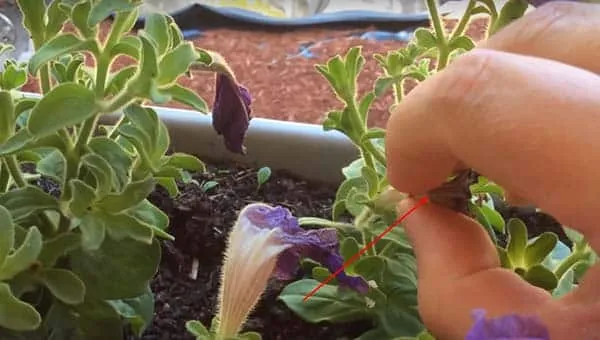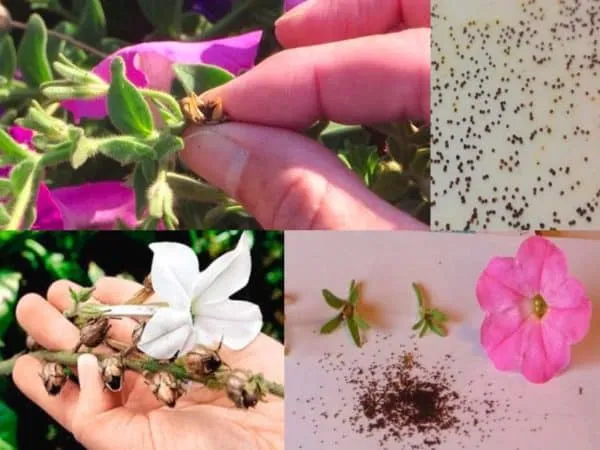Petunias are cherished for their rapid growth, beautiful, abundant, and long-lasting blooms. There’s unparalleled joy for a gardener in growing a flower from a tiny seed. Watching a seedling emerge from a speck and transform into a stunning, flowering plant evokes strong emotions and pride in the work accomplished. To achieve this, high-quality planting material is essential. Let’s explore how to collect petunia seeds, when to do it, and the best storage practices.
Table of contents
Is it possible to collect petunia seeds yourself?

Petunias are flowering herbaceous or semi-shrub plants, known for their variety of species and cultivars. Gardeners typically grow them as annuals, decorating balconies, flower beds, and front gardens.
Note. You can collect seeds from any petunia variety except double-flowered (marigold) and trailing types.
The best option for seed collection is simple, single-coloured varieties, as new plants will fully replicate the parent’s characteristics – from flower colour and shape to bush features. White, pink, purple, and lilac hues are reliably inherited, while red and yellow may slightly shift in shade.
Hybrid petunias also produce seeds, but the seedlings will differ significantly from the parent plants. Hybrid offspring rarely replicate flower form and colour – only in 30–40% of cases.
How to properly collect petunia seeds at home

The seed collection process is the same for all petunia varieties and involves several steps:
- Selecting a healthy parent plant.
- Ensuring seed pods mature fully.
- Collecting the seeds carefully.
- Properly drying and curing the seeds.
Exceptions are trailing and double-flowered varieties. Trailing petunias are finicky and best propagated vegetatively. Double-flowered types don’t produce seeds – their ovary transforms into extra petals, creating the marigold effect. These must be propagated vegetatively.
When to collect
Seeds mature about 3 months after abundant flowering begins. The ideal collection period is August and September.
Note. Collect on dry, sunny, and windless days.
Ripe seed pods turn dry and light brown or yellowish. Timing is crucial – if delayed, the pods burst open, scattering seeds.
Where to find the seeds
To locate petunia seeds, observe faded flowers. A seed pod forms where the flower withered. It’s oval, slightly pointed, and two-valved – initially green, then light brown or yellowish when ripe. Dry pods measure about 10×8 mm.
Inside are tiny seeds (under 0.6 mm, lighter than poppy seeds), dark brown or black. Each pod holds around 100 seeds.
Collecting and preparing seeds

Collecting petunia seeds is a meticulous process:
- Gently remove dried flowers without damaging the stem, sepals, or receptacle. Lower flowers produce seeds faster.
- A small green pod forms beneath the flower. After ~3 weeks, it dries, turns light brown, and slightly enlarges.
- Cut ripe pods with sepals attached and place them on white paper indoors.
- Open pods and pour seeds onto a white surface for visibility.
Dry seeds for 2–3 days at room temperature away from sunlight. Then store for curing.
Storing seeds
Transfer dried seeds to labelled paper envelopes, noting the variety, colour, and traits.
Store at room temperature in a dark, dry place. Avoid heat sources to preserve germination rates.
Note. Properly stored seeds remain viable for up to 4 years.
Sow petunia seeds for seedlings in early February or March for blooms by May–early June.
Conclusion
Petunias are beloved summer plants, admired for their hardiness, rapid growth, and vibrant flowers. Many gardeners wish to preserve favourite varieties, making seed collection and seedling cultivation popular.
Simple single-coloured petunias are best for seed saving, as they retain parent traits. Hybrid seeds often produce different plants, while trailing and double-flowered types require vegetative propagation.







